Comparison of Methods for Determining the Thresholds of Geochemical Anomalies and the Prospecting Direction—A Case of Gold Deposits in the Gouli Exploration Area, Qinghai Province
Abstract
:1. Introduction
2. Study Area and Data
2.1. Geological Settings
2.2. Data Sources and Eigenvalues Statistics
3. Methods
3.1. Cumulative Frequency Method
3.2. Local Singularity Analysis
3.3. Exploration Data Analysis Method
3.4. Robust Principal Component Analysis
4. Results
4.1. The Results Processed by Cumulative Frequency Method, Local Singularity Analysis and Exploration Data Analysis Method
4.2. The Results Processed by RPCA
5. Discussion
5.1. Relationship between Fracture and Mineralization
5.2. The Choice of the Optimal Solution Method
5.3. Mineralization-Related Associated Elements
5.4. Delineation of Prospecting Targets and Anomaly Verification
6. Conclusions
Author Contributions
Funding
Acknowledgments
Conflicts of Interest
Appendix A
#include <stdio.h>
#include <stdlib.h>
main()
{
FILE *fp;
char filename [50];//Used to store the filename.
int i,j, n,flag;
float data[1 00000] = {0},temp,t,num;
printf(" Please input the filename: ");
gets(filename);
//The TXT file and C program engineering files must be placed in the same folder.
fp=fopen(filename,"r");
//Input the amount of the element.
scanf("%d",&n);
for(i=0;i<n;i++)
fscanf(fp,"%f",&data[i]);
fclose(fp);
for(i=0;i<n;i++)
printf("%.2f\n",data[i]);
for(j=0;j<n-1;j++)
{ //Traversing all data of the element concentration.
for(i=0;i<n-1-j;i++)
{ //Sorting the elements from small to large.
if(data[i]> data[i+1])
{
temp=data[i];
data[i]= data[i+1];
data[i+1]=temp;
}
}
}
for(i=0;i<n;i++)
{
t=float(i+1);
num=float(n);
if(t/num>=0.85)
{//Determine the location of elements at a cumulative frequency of 85%.
flag=i;
break;
}
}
//Determine the abnormal threshold value of this element.
printf("The abnormal threshold of the element is %.2f ppb.\n",data[flag]);
}
References
- Cheng, Q.M. Singularity theory and methods for mapping geochemical anomalies caused by buried sources and for predicting undiscovered mineral deposits in covered areas. J. Geochem. Explor. 2012, 122, 55–70. [Google Scholar] [CrossRef]
- Cheng, Q.M. Vertical distribution of elements in regolith over mineral deposits and implications for mapping geochemical weak anomalies in covered areas. Geochem. Explor. Env. Anal. 2014, 143, 277–289. [Google Scholar] [CrossRef]
- Zheng, Y.Y.; Sun, X.; Gao, S.B.; Wang, C.M.; Zhao, Z.Y.; Wu, S.; Li, J.D.; Wu, X. Analysis of stream sediment data for exploring the Zhunuo porphyry Cu deposit, southern Tibet. J. Geochem. Explor. 2014, 143, 19–30. [Google Scholar] [CrossRef]
- Zuo, R.G.; Wang, J.; Chen, G.X.; Yang, M.G. Identification of weak anomalies: A multifractal perspective. J. Geochem. Explor. 2015, 148, 12–24. [Google Scholar] [CrossRef]
- Wang, J.; Zuo, R.G. An extended local gap statistic for identifying geochemical anomalies. J. Geochem. Explor. 2016, 164, 86–93. [Google Scholar] [CrossRef]
- Chen, J.J. Paleozoic-Mesozoic Tectono-Magmatic Evolution and Gold Mineralization in Gouli Area, East End of East Kunlun Orogen. Ph.D. Thesis, China University of Geosciences, Wuhan Shi, China, 2018. [Google Scholar]
- Yang, B.R.; Zhang, L.B.; Ma, Z.X.; Wang, X.Y. Study on Metallogenic Geological Background of Gold Deposits in Gouli Area, Qinghai. Min. Explor. 2018, 9, 1920–1925. [Google Scholar]
- Yan, Q.Z.; Pei, X.Z.; Li, R.B.; Li, Z.C.; Pei, L.; Liu, C.J.; Chen, Y.X.; Hu, C.G.; Zhang, Y.; Wang, X.; et al. Detrital Zircon U-Pb Age and Geological Significance of Metamorphic Strata at Gouli Area in the Central Tectonic Belt of East Kunlun. Northwestern Geol. 2017, 50, 165–181. [Google Scholar]
- Wang, L.W.; Yu, Y.Q.; Zhao, Y.J.; Liu, S.L. Geological Characteristics and Signs of Uranium Polymetallic Deposits in Eastern Meadow of Qinghai Province. Chin. Manganese Ind. 2017, 35, 45–54. [Google Scholar]
- Chen, G.J. Metallogenesis of Gold Deposits in Gouli Regional and Peripheral Area of East Kunlun, Qinghai Province. Ph.D. Thesis, Jilin University, Changchun, China, 2014. [Google Scholar]
- Gobett, G.J.S.; Goodfellow, W.D.; Chapman, R.P.; Chork, C.K. Exploration geochemistry—Distribution of elements and recognition of anomalies. J. Int. Assoc. Math. Geol. 1975, 7, 415–442. [Google Scholar]
- Luo, X.R.; Wen, M.L.; Fei, O.Y. Exploration Geochemistry Beijing. Metall. Ind. Press 2007, 196–199. [Google Scholar]
- Zhou, J.T.; Zhao, B. Identification and evaluation of low level display strata in geochemical logging. Mud Logging Eng. 2003, 2, 43–47. [Google Scholar]
- Li, X.H.; Li, C.L. A new method for fast delineation of geochemical synthetic anomalies-Mahalanobis distance method and program. Comput. Tech. Geophys. Geochem. Explor. 1993, 4, 338–341. [Google Scholar]
- Ma, W.Y. Extraction and Evaluation of Geochemical Anomaly Information; Northwest Normal University: Lanzhou Shi, China, 2013. [Google Scholar]
- Miller, R.L.; Goldberg, E.D. The normal disteribution in geochemistry. Geochim. Cosmochim. Acta. 1995, 8, 53–62. [Google Scholar] [CrossRef]
- Chen, X.; Xu, R.K.; Zheng, Y.Y.; Jiang, X.J.; Du, W.Y. Identifying potential Au-Pb-Ag mineralization in SE Shuangkoushan, North Qaidam, Western China: Combined log-ratio approach and singularity mapping. J. Geochem. Explor. 2018, 189, 109–121. [Google Scholar] [CrossRef]
- Li, Q.Z.; Zhou, J.; Liu, L.; Zhang, J.R.; Zhang, J.C. Comparison of methods for determining the threshold of geochemical anomalies of rocks: A case study of Sigu tin deposit, Yunnan Province. Contrib. Geol. Miner. Resour. Res. 2015, 30, 429–434. [Google Scholar]
- Zhao, C.S. Gold and Silver Mineralization in Eastern Kunlun Orogenic Belt, Qinghai Province(D); Jilin University: Changchun Shi, China, 2004. [Google Scholar]
- Xia, R. Paleo-Tethys Orogenic Process and Gold Mineralization in East Kunlun (D); China University of Geosciences: Beijing, China, 2017. [Google Scholar]
- Shi, C.; Li, R.S.; He, S.P.; Yu, P.S.; Wang, C. Determination of the Age for Gold Mineralization and its Relationship with Tectonomagmatism in the Eastern Segment of Kunlun Orogenic Belt; Summary of theses of the Annual Meeting of the Chinese Geological Society in 2013-The Branch of Metallogenic Law and Prospecting Breakthrough of the Important Metallogenic Belts in Northwest China; China Geological Society: Bejing, China, 2013; p. 3. [Google Scholar]
- Wang, X.Y.; Ma, Z.X.; Li, W.J.; Zhang, X.Y.; Cui, Z.Y. Geological characteristics and ore-controlling factors of gold deposits in Gouli area of Qinghai Province. Chin. Manganese Ind. 2017, 35, 45–54. [Google Scholar]
- Wang, F.L.; Xiao, X.Q.; Chen, S.S. Geological characteristics and prospecting prospects of gold deposits in Gouli area, Qinghai. Gold Sci. Technol. 2011, 19, 45–48. [Google Scholar]
- Xie, X.J.; Wang, X.Q.; Zhang, Q.; Zhou, G.H.; Cheng, H.X.; Liu, D.; Cheng, Z.Z.; Xu, S.F. Multi-scale geochemical mapping in China. Geochem. Explor. Environ. Anal. 2008, 8, 333–341. [Google Scholar] [CrossRef]
- Xie, X.J.; Mu, X.Z.; Ren, T.X. Geochemical mapping in China. J. Geochem. Explor. 1997, 60, 99–113. [Google Scholar]
- Ren, J.F.; Zhou, J.B.; Lu, X.G.; Lin, J.; Mu, K.L. EDXRF-1024 Portable High Precision X-ray Fluorescence Analyzer. Nucl. Sci. Tech. 2006, 9, 698–700. [Google Scholar]
- Yuan, Y.T. Comparative Study of Geochemical Data Processing Methods. Ph.D. Thesis, China University of Geosciences, Beijing, China, 2015. [Google Scholar]
- Chen, J.R.; Wang, J.W.; Fu, F. Various Methods for Determining the Threshold of Geochemical Anomalies and the Discussion of Rationality; Collection of Papers II of Geological Society of Jiangxi Province in 2015; Geological Society of Jiangxi Province: Nanchang Shi, China, 2015. [Google Scholar]
- Xiong, C.; Ge, L.Q.; Luo, Y.Y.; Gu, Y. Comparison of multiple method to determine the geochemical anomalies in the threshold. Sichuan Nonferrous Met. 2012, 1, 52–61. [Google Scholar]
- Yang, X.F.; Liu, C.G.; Zhang, T.R.; Zheng, Y. Geochemical Prospecting Method; Geological Publishing House: Bejing, China, 2007. [Google Scholar]
- Sanderson, D.J.; Roberts, S.; Gumiel, P.A. Fractal relationship between vein thickness and gold grade in drill core from La Codosera Spain. Econ. Geol. 1994, 89, 168–173. [Google Scholar] [CrossRef]
- Ding, S.J.; Zhai, Y.S.; Deng, J. Fractal Study on the Distribution of Gold Deposits in China. Geol. Rev. 1998, 44, 188–193. [Google Scholar]
- Shi, J.F. Geochemical Distribution and Scaling Law of Elements in Zhuji, Zhejiang Province. Geosci. J. Chin. Univ. Geosci. 2001, 26, 167–171. [Google Scholar]
- Cheng, Q.M. Mapping singularities with stream sediment geochemical data for prediction of undiscovered mineral deposits in Gejiu, Yunnan Province, China. Ore Geol. Rev. 2007, 32, 314–324. [Google Scholar] [CrossRef]
- Cheng, Q.M. Non-linear theory and power-law models for information integration and mineral resources quantitative assessments. Math. Geosci. 2008, 40, 503–532. [Google Scholar] [CrossRef]
- Cheng, Q.M.; Agterberg, F.P. Singularity analysis of ore-mineral and toxic trace elements in stream sediments. Comput. Geosci. 2009, 35, 234–244. [Google Scholar] [CrossRef]
- Agterberg, F.P. Multifractals and geostatistics. J. Geochem. Explor. 2012, 122, 113–123. [Google Scholar] [CrossRef]
- Shi, C.Y. Application of exploration data analysis (EDA) technology. Geol. Explor. 1993, 11, 52–58. [Google Scholar]
- Hu, Y.K. Multivariate Analysis in Geochemistry; China University of Geosciences press: Wuhan, China, 1991. [Google Scholar]
- Emmanuei, J.M.; Carranza, E.J.M. Geochemical Anomaly and Mineral Prospectivity Mapping in GIS; The Netherlands Hardbound: Culemborg, The Netherlands, 2008; p. 368. [Google Scholar]
- Chayes, F.; Trochimczyk, J. An effect of closure on the structure of principal components. J. Int. Assoc. Math. Geol. 1978, 10, 323–333. [Google Scholar] [CrossRef]
- Aitchison, J. The statistical analysis of compositional data. J. R. Stat. Soc. 1986, 44, 139–177. [Google Scholar]
- Gregory, F.P. The statistical analysis of compositional data. Technometrics 1988, 30, 120–121. [Google Scholar]
- Zhou, D. Statistical Analysis of Geological Compositional Data-Difficulties and Explorations. J. Earth Sci. 1998, 23, 147–152. [Google Scholar]
- Egozcue, J.J.; Pawlowsky-Glahn, V.; Mateu-Figueras, G.; Barcelo-Vidal, C. Isometric logratio transformations for compositional data analysis. Math. Geol. 2003, 35, 279–300. [Google Scholar] [CrossRef]
- Carranza, E.J.M. Analysis and mapping of geochemical anomalies using logratio-transformed stream sediment data with censored values. J. Geochem. Explor. 2011, 110, 167–185. [Google Scholar] [CrossRef]
- Filzmoser, P.; Hron, K.; Reimann, C. Principal component analysis for compositional data with outliers. Envireonmetrics 2009, 20, 621–632. [Google Scholar] [CrossRef]
- Aitchison, L. The statistical analysis of compositional data. J. R. Stat. Soc. Ser. B 1982, 44, 139–177. [Google Scholar] [CrossRef]
- Afzal, P.; Alghalandis, Y.F.; Khakzad, A.; Moarefvand, P.; Omran, N.R. Delineation of mineralization zones in porphyry Cu deposits by fractal concentration-volume modeling. J. Geochem. Explor. 2011, 108, 220–232. [Google Scholar] [CrossRef]
- Filzmoser, P.; Hron, K. Outlier detection for compositional data using robust methods. Math. Geosci. 2008, 40, 233–248. [Google Scholar] [CrossRef]
- Filzmoser, P.; Hron, K. Correlation analysis for compositional data. Math. Geosci. 2009, 41, 905–919. [Google Scholar] [CrossRef]
- Filzmoser, P.; Hron, K.; Reimann, C. Univariate statistical analysis of environmental (compositional) data: Problems and possibilities. Sci. Total Env. 2009, 407, 6100–6108. [Google Scholar] [CrossRef] [PubMed]
- Reimann, C.; Filzmoser, P.; Garrett, R.G. Factor analysis applied to regional geochemical data: Problems and possibilities. Appl. Geochem. 2002, 17, 185–206. [Google Scholar] [CrossRef]
- Zuo, R.G. Identification of geochemical anomalies associated with mineralization in the Fanshan district, Fujian, China. J. Geochem. Explor. 2014, 139, 170–176. [Google Scholar] [CrossRef]
- Zuo, R.G.; Xia, Q.L.; Wang, H.C. Compositional data analysis in the study of integrated geochemical anomalies associated with mineralization. Appl. Geochem. 2013, 28, 202–211. [Google Scholar] [CrossRef]
- Cheng, Q.M. Singular mineralization processes and mineral resources quantitative prediction: New theories and methods. Earth Sci. Front. 2007, 14, 042–053. [Google Scholar]
- Bai, J.; Porwal, A.; Hart, C.; Ford, A.; Yu, L. Mapping geochemical singularity using multifractal analysis: Application to anomaly definition on stream sediments data from Funin Sheet, Yunnan, China. J. Geochem. Explor. 2010, 104, 1–11. [Google Scholar] [CrossRef]
- Liu, Y.; Cheng, Q.M.; Xia, Q.L.; Wang, X.Q. Application of singularity analysis for mineral potential identification using geochemical data-a case study: Nanling W-Sn-Mo polymetallic metallogenic belt, South China. J. Geochem. Explor. 2013, 134, 61–72. [Google Scholar] [CrossRef]
- Sun, X.; Gong, Q.J.; Wang, Q.F.; Yang, L.Q.; Wang, C.M.; Wang, Z.L. Application of local singularity model to delineate geochemical anomalies in Xiong’ershan gold and molybdenum ore district, Western Henan province, China. J. Geochem. Explor. 2010, 107, 21–29. [Google Scholar] [CrossRef]
- Sun, X.; Zheng, Y.Y.; Wang, C.M.; Zhao, Z.Y.; Geng, X.B. Identifying geochemical anomalies associated with Sb–Au–Pb–Zn–Ag mineralization in North Himalaya, southern Tibet. Ore Geol. Rev. 2016, 73, 1–12. [Google Scholar] [CrossRef]
- Wang, W.L.; Zhao, J.; Cheng, Q.M. Application of singularity index mapping technique to gravity/magnetic data analysis in southeastern Yunnan mineral district, China. J. Appl. Geophys. 2013, 92, 39–49. [Google Scholar] [CrossRef]
- Xiao, F.; Chen, J.G.; Zhang, Z.Y.; Wang, C.B.; Wu, G.M.; Agterberg, F.P. Singularity mapping and spatially weighted principal component analysis to identify geochemical anomalies associated with Ag and Pb-Zn polymetallic mineralization in Northwest Zhejiang, China. J. Geochem. Explor. 2012, 122, 90–100. [Google Scholar] [CrossRef]
- Zhao, J.; Zuo, R.; Chen, S.; Kreuzer, O.P. Application of the tectono-geochemistry method to mineral prospectivity mapping: A case study of the Gaosong tin-polymetallic deposit, Gejiu district, SW China. Ore Geol. Rev. 2015, 71, 719–734. [Google Scholar] [CrossRef]
- Zuo, R.G.; Cheng, Q.M.; Agterberg, F.P.; Xia, Q.L. Application of singularity mapping technique to identify local anomalies using stream sediment geochemical data, a case study from Gangdese, Tibet, western China. J. Geochem. Explor. 2009, 101, 225–235. [Google Scholar] [CrossRef]
- Zuo, R.G.; Xia, Q.L.; Zhang, D.J. A comparison study of the C–A and S–A models with singularity analysis to identify geochemical anomalies in covered areas. Appl. Geochem. 2013, 33, 165–172. [Google Scholar] [CrossRef]
- Zuo, R.G.; Carranza, E.J.M.; Wang, J. Spatial analysis and visualization of exploration geochemical data. Earth Sci. Rev. 2016, 158, 9–18. [Google Scholar] [CrossRef]
- Chen, J.; Li, Z.D. Application of 1:10000 soil geochemical survey in the general survey of gold deposits in Gazhima area. Mod. Min. 2016, 32, 188–190. [Google Scholar]
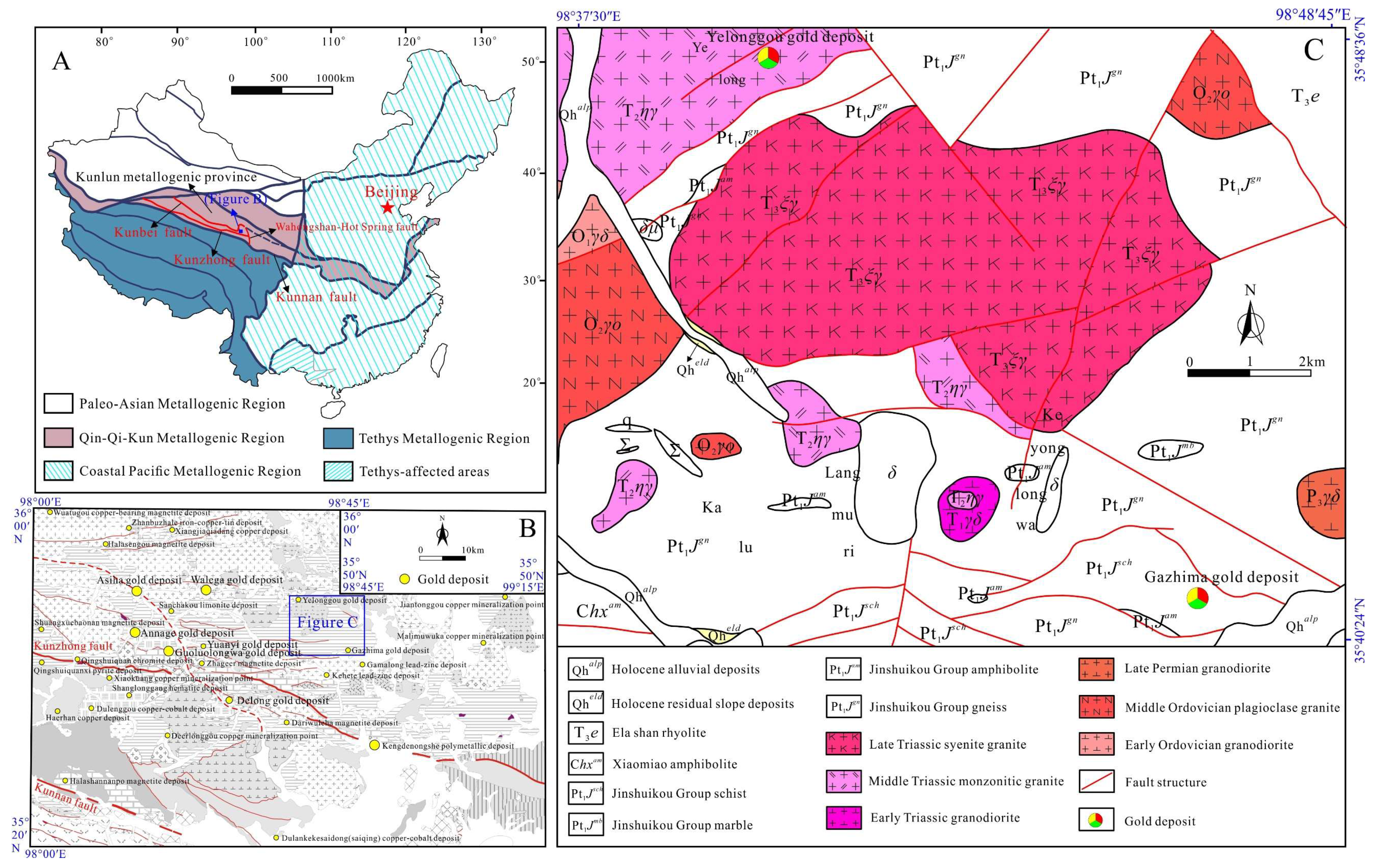
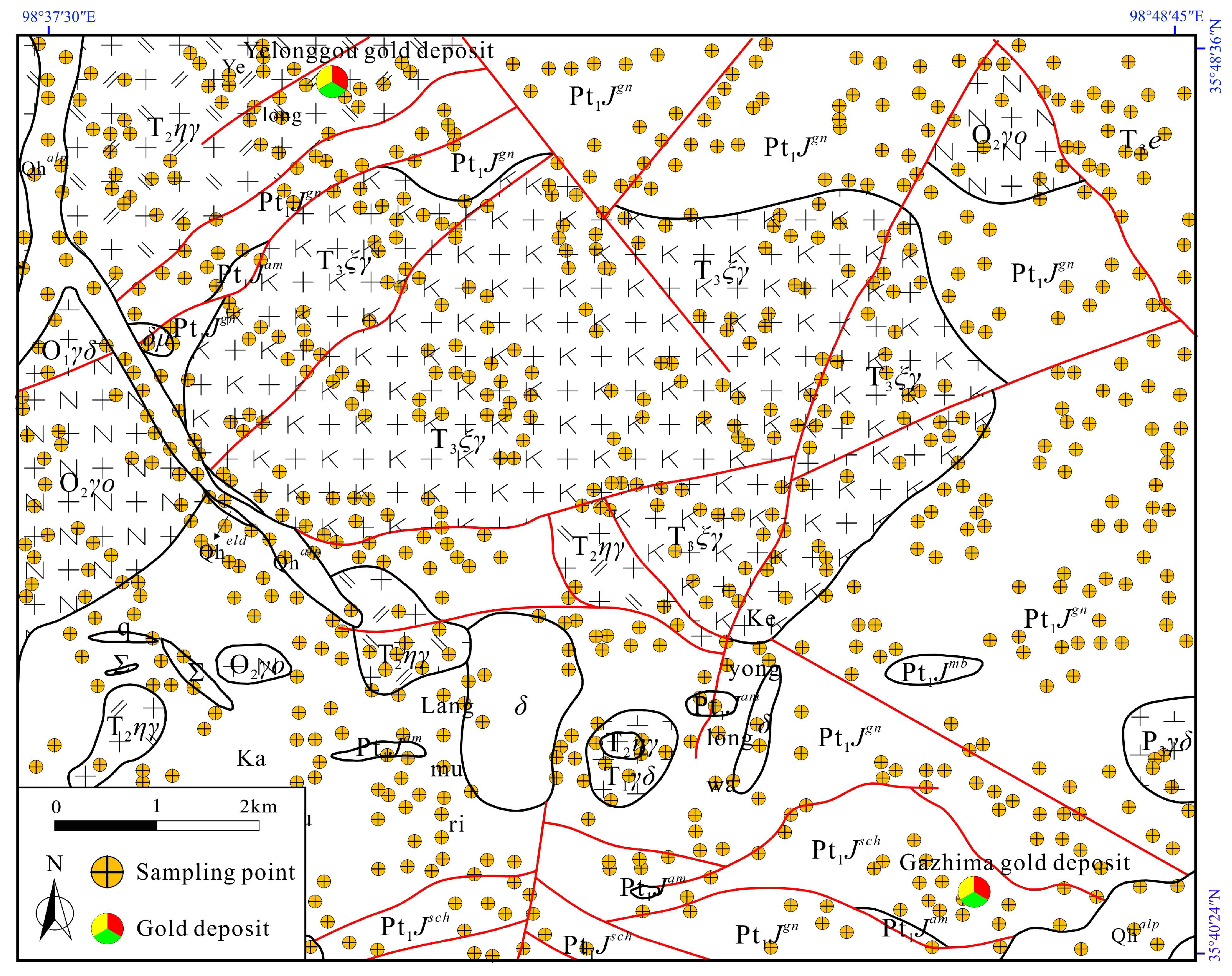
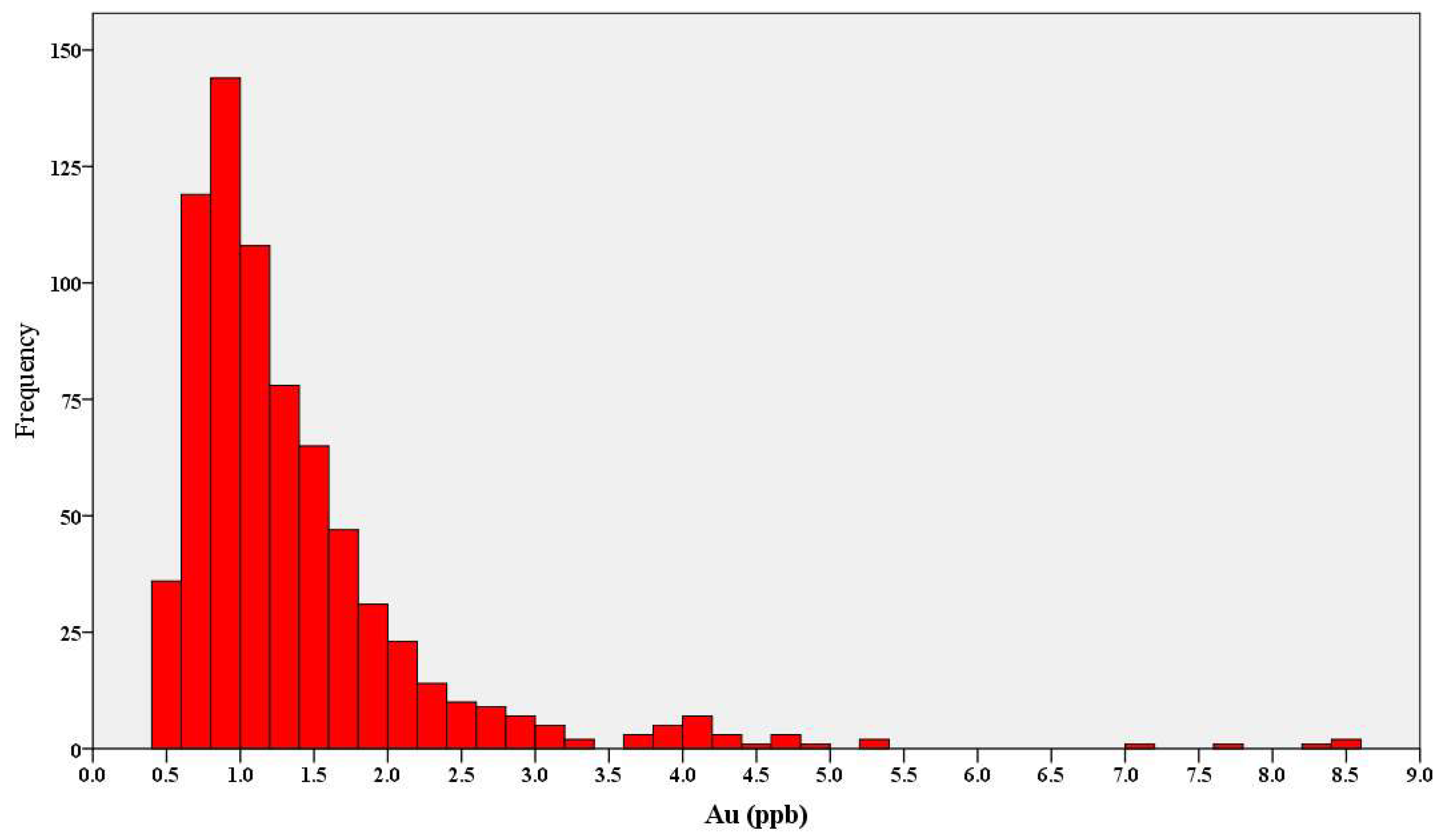

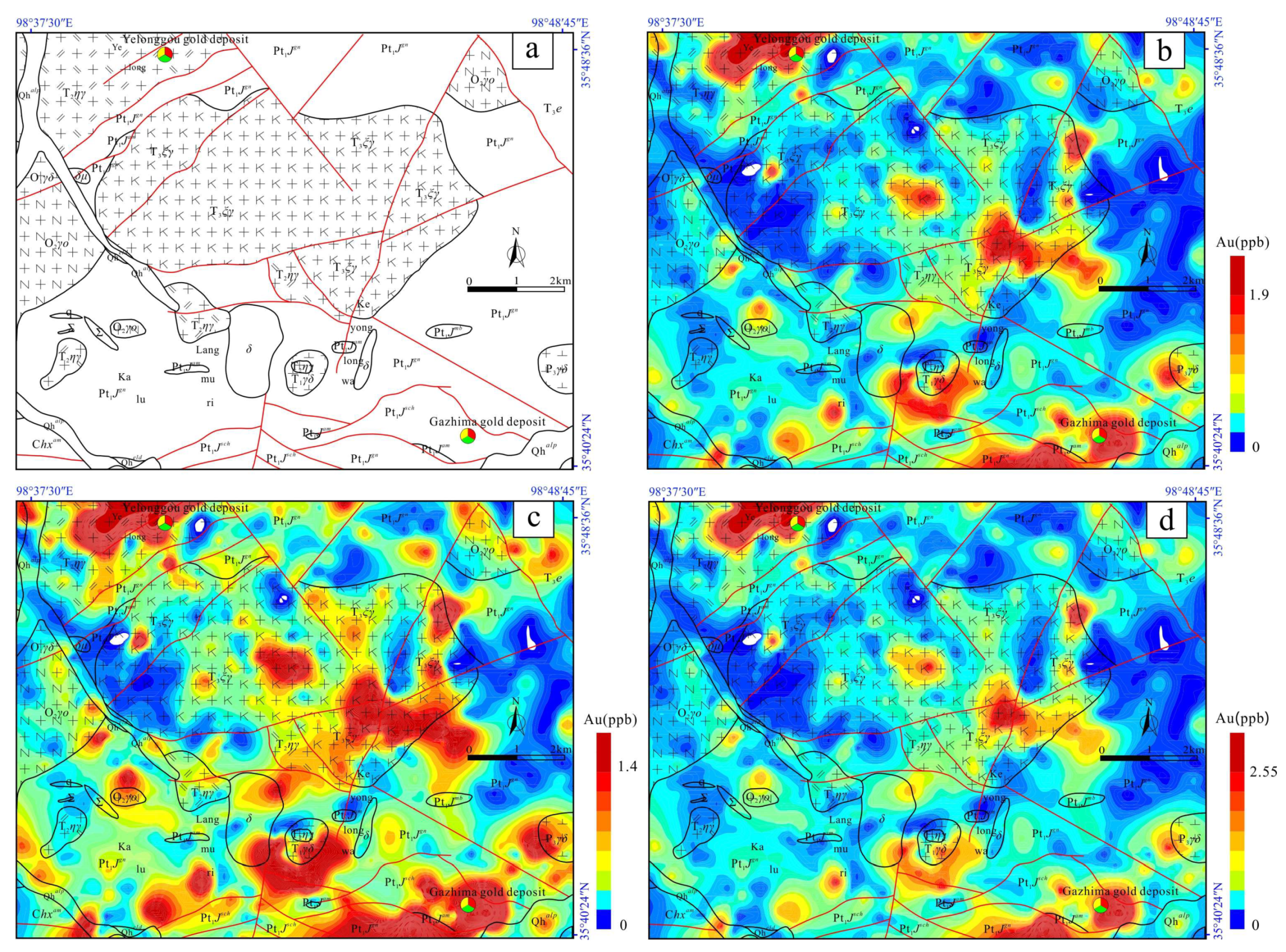
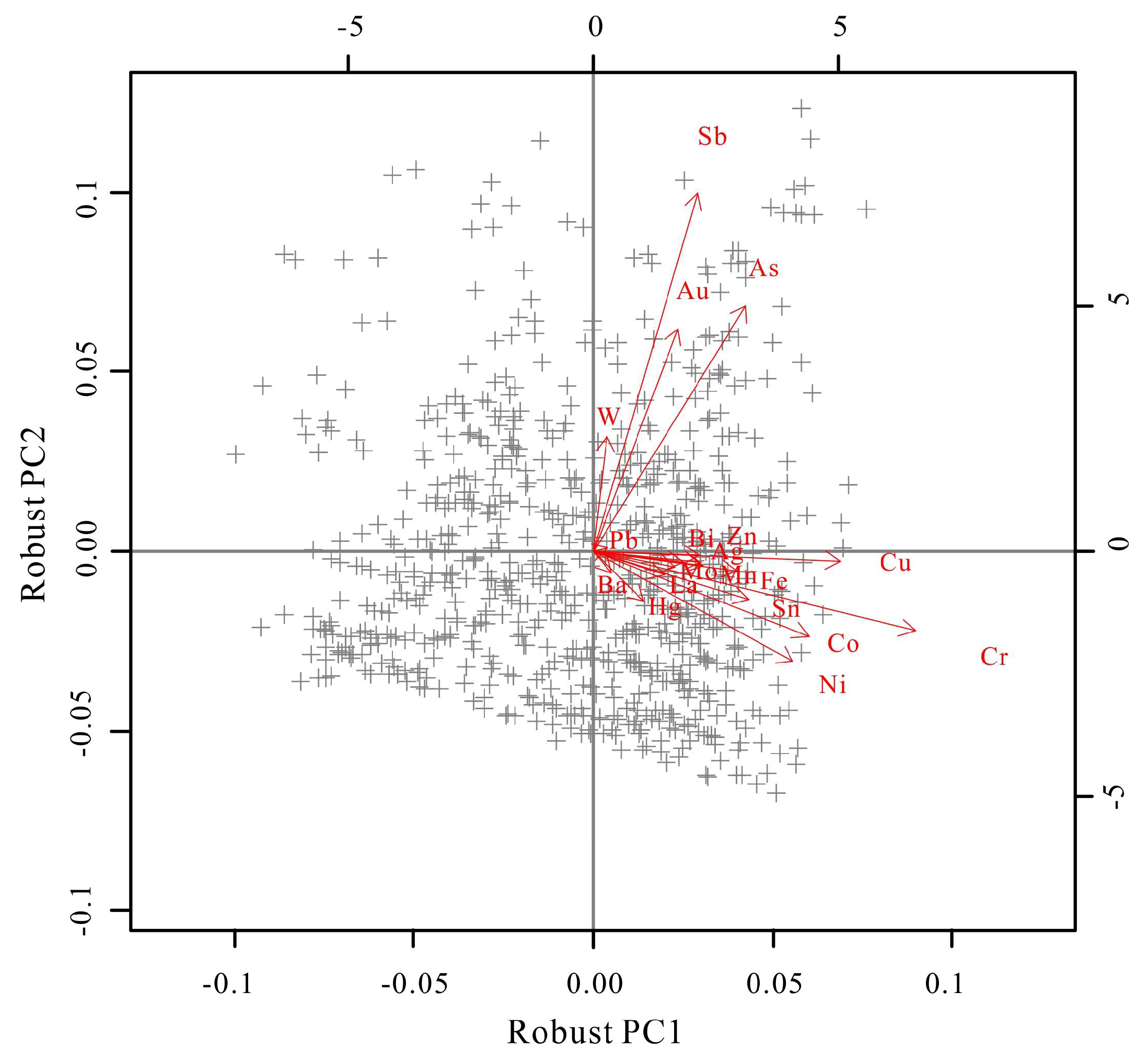
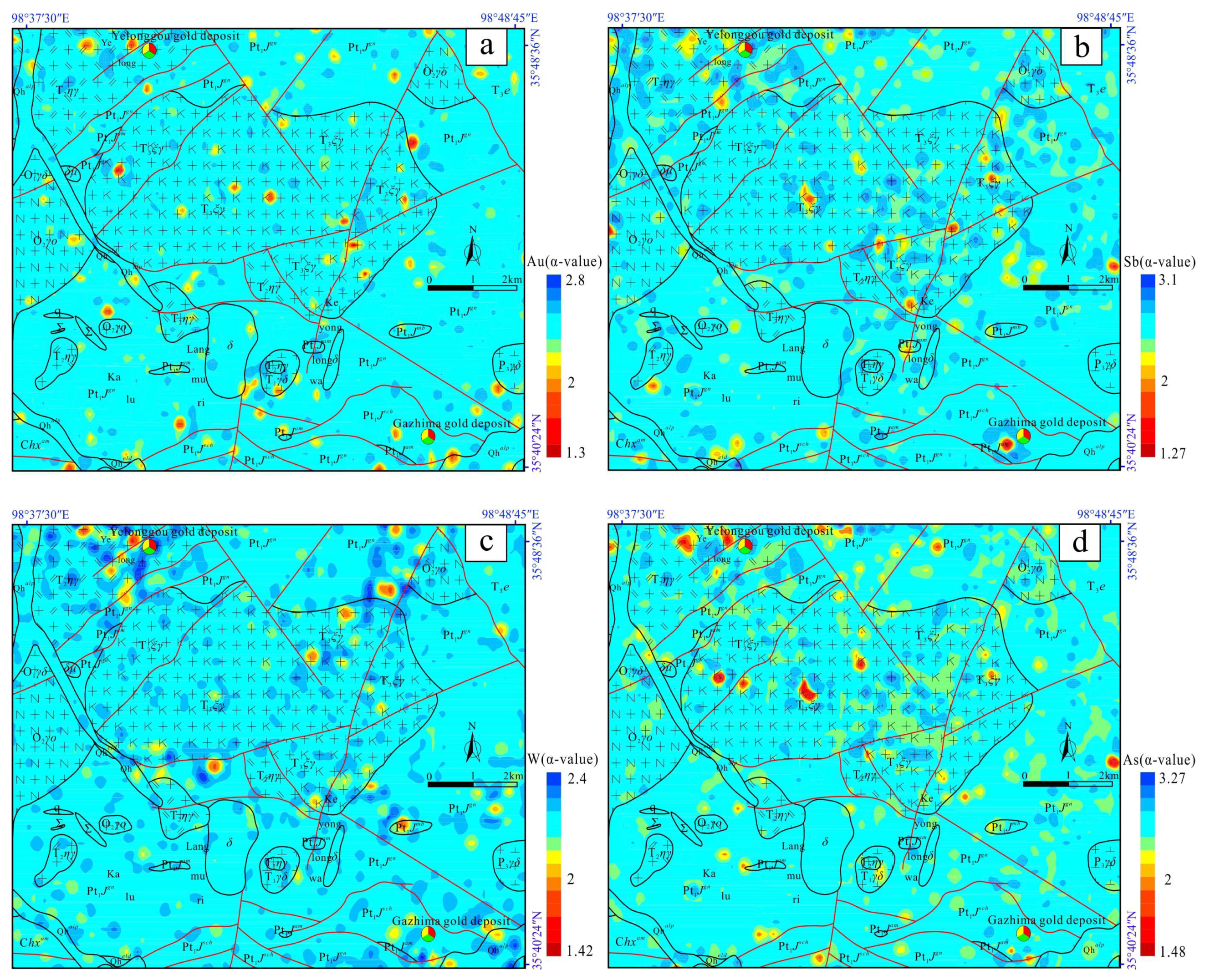
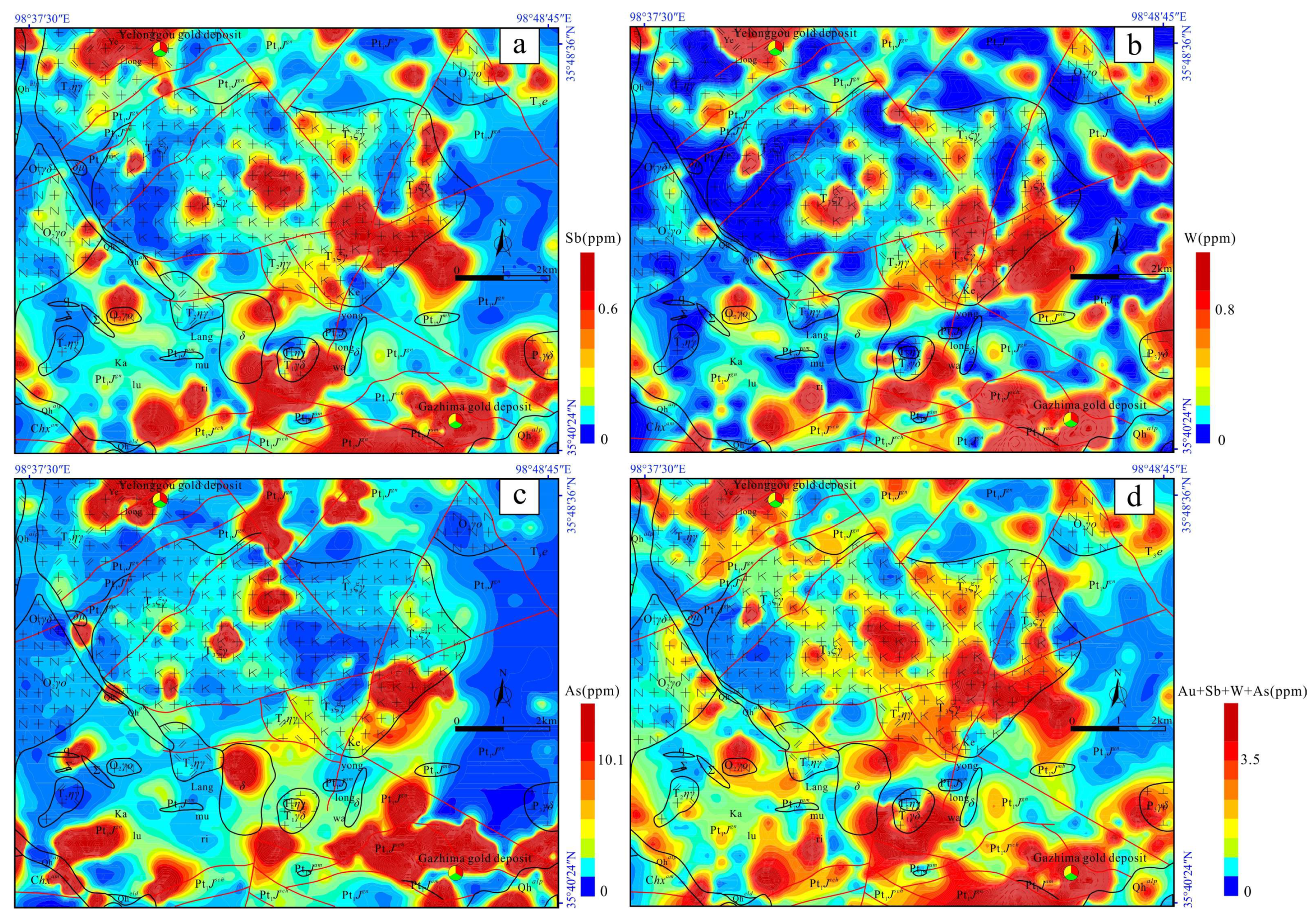
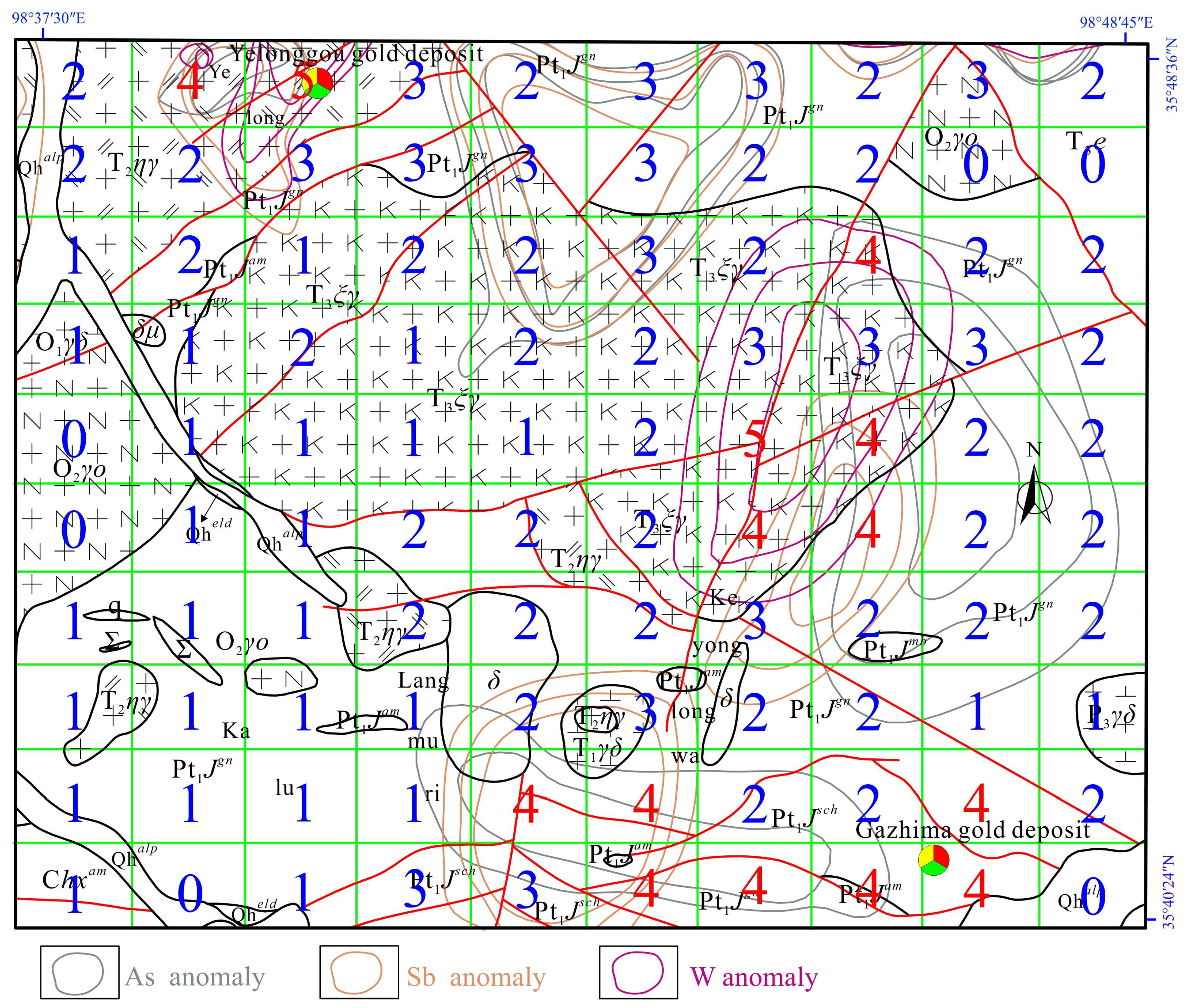
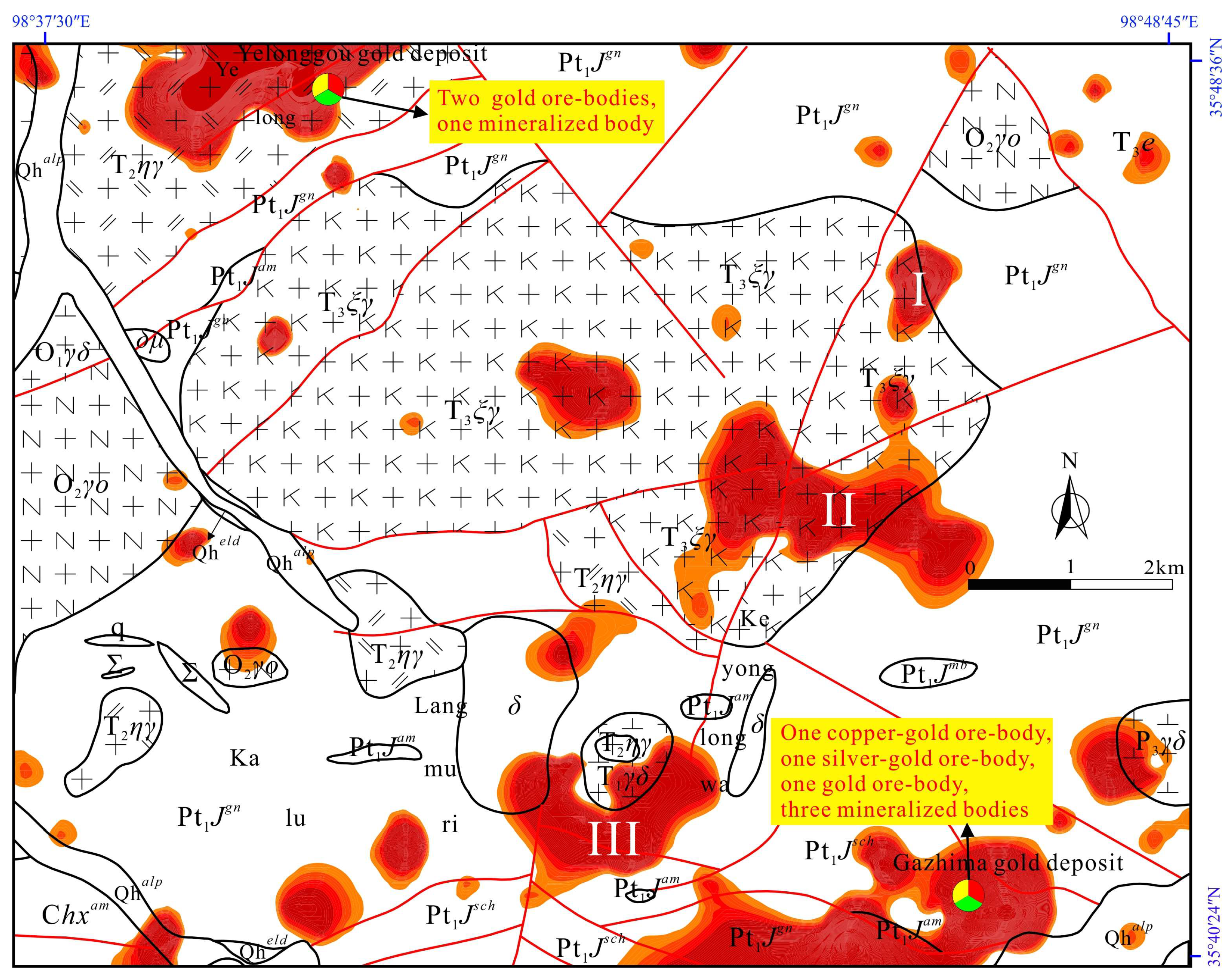

| Geological Units | Amount | Mean Value | Median | Standard Deviation | Variance | Skewness | Kurtosis | Minimum Value | Maximum Value |
|---|---|---|---|---|---|---|---|---|---|
| Whole area | 764 | 1.32 | 1.1 | 0.95 | 0.91 | 3.46 | 17.57 | 0.5 | 8.4 |
| Quaternary | 40 | 1.2 | 1 | 0.75 | 0.57 | 2.55 | 8.14 | 0.5 | 4.4 |
| Late Triassic intrusive rocks | 161 | 1.36 | 1.1 | 0.93 | 0.86 | 3.07 | 14.48 | 0.5 | 7.7 |
| Middle Triassic intrusive rocks | 61 | 1.64 | 1.3 | 1.43 | 2.06 | 3.04 | 10.28 | 0.6 | 8.3 |
| Permian intrusive rocks | 34 | 1.73 | 1.7 | 0.74 | 0.54 | 0.16 | −1.42 | 0.9 | 2.6 |
| Ordovician intrusive rocks | 40 | 1.04 | 0.95 | 0.36 | 0.13 | 1.66 | 4.09 | 0.6 | 2.4 |
| The strata of the Ela mountains | 26 | 1.29 | 1.05 | 0.68 | 0.46 | 0.86 | −0.19 | 0.5 | 2.7 |
| The strata of Jinshuikou Group | 385 | 1.31 | 1 | 0.95 | 0.9 | 3.44 | 17.84 | 0.5 | 8.4 |
| The strata of Xiaomiao | 17 | 1.2 | 0.9 | 0.51 | 0.26 | 1.44 | 1.81 | 0.8 | 2.2 |
| Methods | Abnormal Threshold Values | Abnormal Areas | Geological Body Occurrence |
|---|---|---|---|
| Cumulative frequency method | 1.9 | 9.47 | Triassic intrusive rocks and Jinshuikou Group strata |
| Local singularity analysis | 1.7 | 14 | Triassic intrusive rocks and Jinshuikou Group strata |
| Exploration data analysis method | 2.55 | 7.66 | Triassic intrusive rocks and Jinshuikou Group strata |
| Elements | Maximum Value | Minimum Value | The Concentration at the Same Window as Singularity Index α when Singularity Index (α) Is Close to 2 Infinitely |
|---|---|---|---|
| Au (ppb) | 8.4 | 0.5 | 1.4 |
| Sb (ppm) | 5.16 | 0.2 | 0.6 |
| W (ppm) | 6.05 | 0.5 | 0.8 |
| As (ppm) | 86.79 | 1.95 | 10.1 |
| Au + Sb + W + As (ppm) | 68.54 | 1.86 | 2.4 |
| Output Characteristics of Gold Deposits | Yes (Scoring) | No (Scoring) |
|---|---|---|
| If there are faults or structure alteration zones | 1 | 0 |
| If the geological unit is Triassic intrusive rock or Jinshuikou Group strata | 1 | 0 |
| If mineralization alteration is mainly pyritization, ferritization and galena mineralization | 1 | 0 |
| If there are strong anomalies of Au | 1 | 0 |
| If there are the abnormal compositional elements of Sb, As, and W | 1 | 0 |
© 2019 by the authors. Licensee MDPI, Basel, Switzerland. This article is an open access article distributed under the terms and conditions of the Creative Commons Attribution (CC BY) license (http://creativecommons.org/licenses/by/4.0/).
Share and Cite
Chen, D.; Wei, J.; Wang, W.; Shi, W.; Li, H.; Zhan, X. Comparison of Methods for Determining the Thresholds of Geochemical Anomalies and the Prospecting Direction—A Case of Gold Deposits in the Gouli Exploration Area, Qinghai Province. Minerals 2019, 9, 368. https://doi.org/10.3390/min9060368
Chen D, Wei J, Wang W, Shi W, Li H, Zhan X. Comparison of Methods for Determining the Thresholds of Geochemical Anomalies and the Prospecting Direction—A Case of Gold Deposits in the Gouli Exploration Area, Qinghai Province. Minerals. 2019; 9(6):368. https://doi.org/10.3390/min9060368
Chicago/Turabian StyleChen, Dingjie, Junhao Wei, Wenhui Wang, Wenjie Shi, Huan Li, and Xiaofei Zhan. 2019. "Comparison of Methods for Determining the Thresholds of Geochemical Anomalies and the Prospecting Direction—A Case of Gold Deposits in the Gouli Exploration Area, Qinghai Province" Minerals 9, no. 6: 368. https://doi.org/10.3390/min9060368
APA StyleChen, D., Wei, J., Wang, W., Shi, W., Li, H., & Zhan, X. (2019). Comparison of Methods for Determining the Thresholds of Geochemical Anomalies and the Prospecting Direction—A Case of Gold Deposits in the Gouli Exploration Area, Qinghai Province. Minerals, 9(6), 368. https://doi.org/10.3390/min9060368





